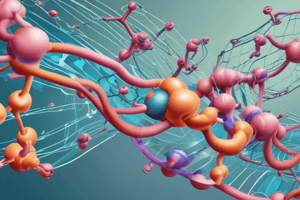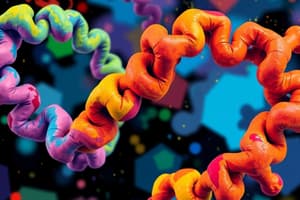Podcast
Questions and Answers
What determines the overall properties of a protein?
What determines the overall properties of a protein?
- Primary structure (correct)
- Secondary structure
- Tertiary structure
- Quaternary structure
What type of bonds stabilize alpha helices and beta sheets?
What type of bonds stabilize alpha helices and beta sheets?
- Disulfide bonds
- Hydrogen bonds (correct)
- Ionic interactions
- Hydrophobic interactions
What contributes to the tertiary structure of a protein?
What contributes to the tertiary structure of a protein?
- Interactions between side chains and the backbone (correct)
- Hydrophobic interactions only
- Disulfide bonds and ionic interactions only
- Hydrogen bonds only
What is the arrangement of multiple polypeptide chains in a protein?
What is the arrangement of multiple polypeptide chains in a protein?
What is the process by which a polypeptide chain assumes its native 3D structure?
What is the process by which a polypeptide chain assumes its native 3D structure?
What can lead to diseases such as Alzheimer's and cancer?
What can lead to diseases such as Alzheimer's and cancer?
What is the loss of native structure and function due to external factors?
What is the loss of native structure and function due to external factors?
What can be a result of denaturation?
What can be a result of denaturation?
Flashcards are hidden until you start studying
Study Notes
Protein Structure
Primary Structure
- Sequence of amino acids in a polypeptide chain
- Determined by the sequence of nucleotides in the gene that encodes the protein
- Primary structure determines the overall properties of a protein
Secondary Structure
- Local arrangements of amino acids that are stabilized by hydrogen bonds
- Alpha helices (α-helices) and beta sheets (β-sheets) are common secondary structures
- Alpha helices: spiral shape, hydrogen bonds between every 4th amino acid
- Beta sheets: flat, extended, hydrogen bonds between amino acids in parallel or antiparallel chains
Tertiary Structure
- 3D arrangement of amino acids in a polypeptide chain
- Determined by interactions between side chains (R groups) and the backbone
- Hydrophobic interactions, ionic interactions, and disulfide bonds contribute to tertiary structure
Quaternary Structure
- Arrangement of multiple polypeptide chains (subunits) in a protein
- Subunits are held together by non-covalent interactions (hydrogen bonds, ionic interactions, etc.)
- Quaternary structure is important for protein function and stability
Protein Folding
- Process by which a polypeptide chain assumes its native 3D structure
- Influenced by factors such as temperature, pH, and the presence of chaperone proteins
- Misfolded proteins can lead to diseases such as Alzheimer's and cancer
Denaturation
- Loss of native structure and function due to external factors (heat, pH, chemicals, etc.)
- Can be reversible or irreversible, depending on the severity of denaturation
- Denaturation can lead to protein aggregation and precipitation
Protein Structure
- A protein's primary structure is the sequence of amino acids in a polypeptide chain, determined by the sequence of nucleotides in the gene that encodes the protein.
- Primary structure determines the overall properties of a protein.
Secondary Structure
- Local arrangements of amino acids are stabilized by hydrogen bonds, forming alpha helices (α-helices) and beta sheets (β-sheets).
- Alpha helices: spiral shape, hydrogen bonds between every 4th amino acid.
- Beta sheets: flat, extended, hydrogen bonds between amino acids in parallel or antiparallel chains.
Tertiary Structure
- The 3D arrangement of amino acids in a polypeptide chain is determined by interactions between side chains (R groups) and the backbone.
- Hydrophobic interactions, ionic interactions, and disulfide bonds contribute to tertiary structure.
Quaternary Structure
- The arrangement of multiple polypeptide chains (subunits) in a protein is held together by non-covalent interactions (hydrogen bonds, ionic interactions, etc.).
- Quaternary structure is important for protein function and stability.
Protein Folding
- Protein folding is the process by which a polypeptide chain assumes its native 3D structure.
- Factors influencing protein folding include temperature, pH, and the presence of chaperone proteins.
- Misfolded proteins can lead to diseases such as Alzheimer's and cancer.
Denaturation
- Denaturation is the loss of native structure and function due to external factors (heat, pH, chemicals, etc.).
- Denaturation can be reversible or irreversible, depending on the severity of denaturation.
- Denaturation can lead to protein aggregation and precipitation.
Studying That Suits You
Use AI to generate personalized quizzes and flashcards to suit your learning preferences.



